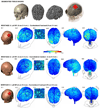Electrode montages for tDCS and weak transcranial electrical stimulation: role of "return" electrode's position and size
- PMID: 21035740
- PMCID: PMC2983105
- DOI: 10.1016/j.clinph.2010.05.020
Electrode montages for tDCS and weak transcranial electrical stimulation: role of "return" electrode's position and size
Figures

Comment on
-
Electrode-distance dependent after-effects of transcranial direct and random noise stimulation with extracephalic reference electrodes.Clin Neurophysiol. 2010 Dec;121(12):2165-71. doi: 10.1016/j.clinph.2010.04.033. Epub 2010 Jun 15. Clin Neurophysiol. 2010. PMID: 20554472
References
-
- Accornero N, Li Voti P, La Riccia M, Gregori B. Visual evoked potentials modulation during direct current cortical polarization. Exp Brain Res. 2007;178(2):261–266. - PubMed
-
- Bikson M, Bulow P, Stiller JW, Datta A, Battaglia F, Karnup SV, et al. Transcranial direct current stimulation for major depression: a general system for quantifying transcranial electrotherapy dosage. Curr Treat Options Neurol. 2008;10:377–385. - PubMed
-
- Datta A, Elwassif M, Battaglia F, Bikson M. Transcranial current stimulation focality using disc and ring electrode configurations:FEM analysis. J Neural Eng. 2008;5:163–174. - PubMed
Publication types
MeSH terms
Grants and funding
LinkOut - more resources
Full Text Sources
Other Literature Sources

